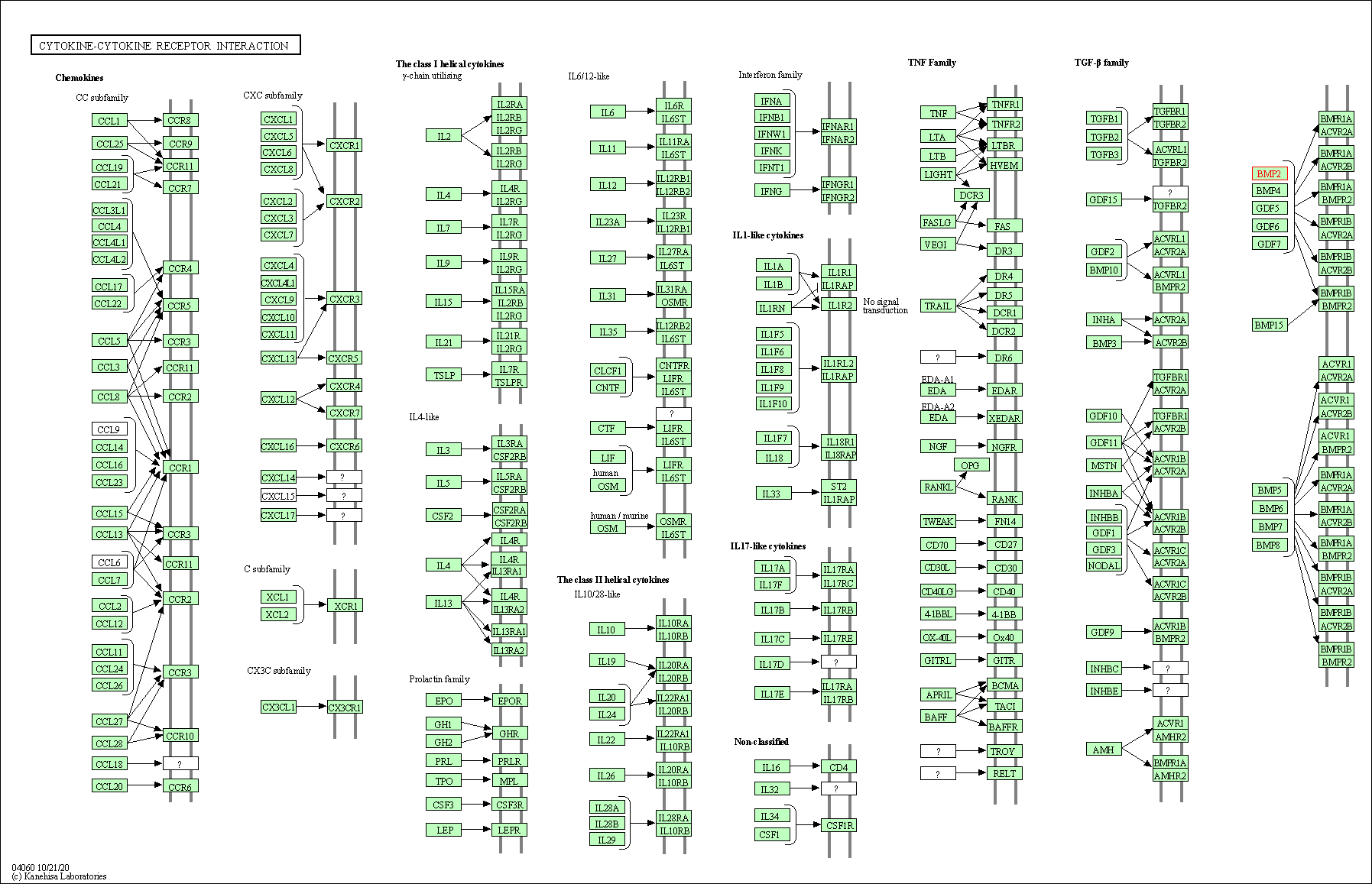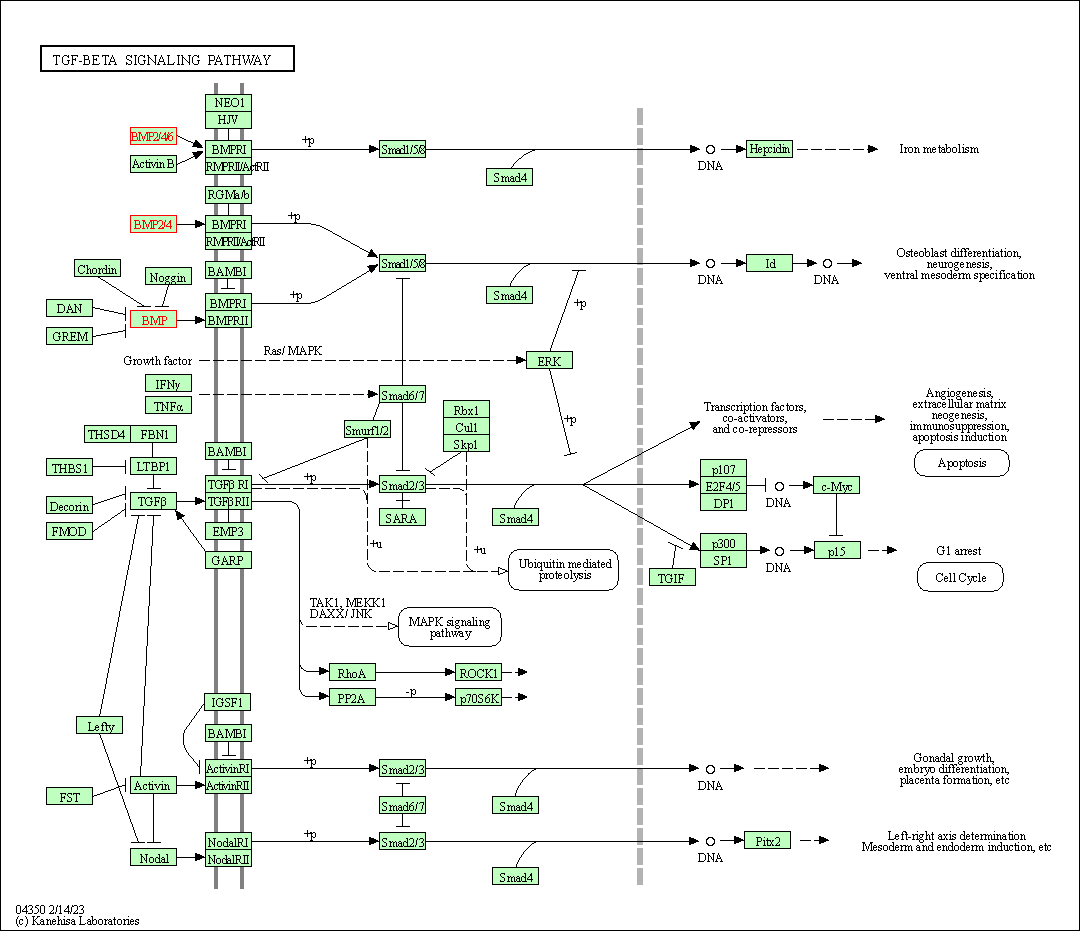Target Information
| Target General Information | Top | |||||
|---|---|---|---|---|---|---|
| Target ID |
T68383
(Former ID: TTDI01983)
|
|||||
| Target Name |
Bone morphogenetic protein 2 (BMP2)
|
|||||
| Synonyms |
Bone morphogenetic protein 2A; BMP2A; BMP-2A; BMP-2
Click to Show/Hide
|
|||||
| Gene Name |
BMP2
|
|||||
| Target Type |
Clinical trial target
|
[1] | ||||
| Disease | [+] 1 Target-related Diseases | + | ||||
| 1 | Bone growth disorder [ICD-11: FB86] | |||||
| Function |
Stimulates the differentiation of myoblasts into osteoblasts via the EIF2AK3-EIF2A- ATF4 pathway. BMP2 activation of EIF2AK3 stimulates phosphorylation of EIF2A which leads to increased expression of ATF4 which plays a central role in osteoblast differentiation. In addition stimulates TMEM119, which upregulates the expression of ATF4. Induces cartilage and bone formation.
Click to Show/Hide
|
|||||
| BioChemical Class |
Growth factor
|
|||||
| UniProt ID | ||||||
| Sequence |
MVAGTRCLLALLLPQVLLGGAAGLVPELGRRKFAAASSGRPSSQPSDEVLSEFELRLLSM
FGLKQRPTPSRDAVVPPYMLDLYRRHSGQPGSPAPDHRLERAASRANTVRSFHHEESLEE LPETSGKTTRRFFFNLSSIPTEEFITSAELQVFREQMQDALGNNSSFHHRINIYEIIKPA TANSKFPVTRLLDTRLVNQNASRWESFDVTPAVMRWTAQGHANHGFVVEVAHLEEKQGVS KRHVRISRSLHQDEHSWSQIRPLLVTFGHDGKGHPLHKREKRQAKHKQRKRLKSSCKRHP LYVDFSDVGWNDWIVAPPGYHAFYCHGECPFPLADHLNSTNHAIVQTLVNSVNSKIPKAC CVPTELSAISMLYLDENEKVVLKNYQDMVVEGCGCR Click to Show/Hide
|
|||||
| 3D Structure | Click to Show 3D Structure of This Target | AlphaFold | ||||
| HIT2.0 ID | T31SX8 | |||||
| Drugs and Modes of Action | Top | |||||
|---|---|---|---|---|---|---|
| Clinical Trial Drug(s) | [+] 1 Clinical Trial Drugs | + | ||||
| 1 | DWP-431 | Drug Info | Phase 3 | Bone development disorder | [2] | |
| Mode of Action | [+] 1 Modes of Action | + | ||||
| Modulator | [+] 1 Modulator drugs | + | ||||
| 1 | DWP-431 | Drug Info | [1] | |||
| Cell-based Target Expression Variations | Top | |||||
|---|---|---|---|---|---|---|
| Cell-based Target Expression Variations | ||||||
| Drug Binding Sites of Target | Top | |||||
|---|---|---|---|---|---|---|
| Ligand Name: Mesotartaric acid | Ligand Info | |||||
| Structure Description | Crystal structure of the ternary RGMB-BMP2-NEO1 complex | PDB:4UI2 | ||||
| Method | X-ray diffraction | Resolution | 3.15 Å | Mutation | No | [3] |
| PDB Sequence |
KSSCKRHPLY
302 VDFSDVGWND312 WIVAPPGYHA322 FYCHGECPFP332 LADHLNSTNH342 AIVQTLVNSV 352 NSKIPKACCV362 PTELSAISML372 YLDENEKVVL382 KNYQDMVVEG392 CGCR |
|||||
|
|
||||||
| Click to View More Binding Site Information of This Target with Different Ligands | ||||||
| Different Human System Profiles of Target | Top |
|---|---|
|
Human Similarity Proteins
of target is determined by comparing the sequence similarity of all human proteins with the target based on BLAST. The similarity proteins for a target are defined as the proteins with E-value < 0.005 and outside the protein families of the target.
A target that has fewer human similarity proteins outside its family is commonly regarded to possess a greater capacity to avoid undesired interactions and thus increase the possibility of finding successful drugs
(Brief Bioinform, 21: 649-662, 2020).
Human Pathway Affiliation
of target is determined by the life-essential pathways provided on KEGG database. The target-affiliated pathways were defined based on the following two criteria (a) the pathways of the studied target should be life-essential for both healthy individuals and patients, and (b) the studied target should occupy an upstream position in the pathways and therefore had the ability to regulate biological function.
Targets involved in a fewer pathways have greater likelihood to be successfully developed, while those associated with more human pathways increase the chance of undesirable interferences with other human processes
(Pharmacol Rev, 58: 259-279, 2006).
Biological Network Descriptors
of target is determined based on a human protein-protein interactions (PPI) network consisting of 9,309 proteins and 52,713 PPIs, which were with a high confidence score of ≥ 0.95 collected from STRING database.
The network properties of targets based on protein-protein interactions (PPIs) have been widely adopted for the assessment of target’s druggability. Proteins with high node degree tend to have a high impact on network function through multiple interactions, while proteins with high betweenness centrality are regarded to be central for communication in interaction networks and regulate the flow of signaling information
(Front Pharmacol, 9, 1245, 2018;
Curr Opin Struct Biol. 44:134-142, 2017).
Human Similarity Proteins
Human Pathway Affiliation
Biological Network Descriptors
|
|
|
There is no similarity protein (E value < 0.005) for this target
|
| KEGG Pathway | Pathway ID | Affiliated Target | Pathway Map |
|---|---|---|---|
| Cytokine-cytokine receptor interaction | hsa04060 | Affiliated Target |

|
| Class: Environmental Information Processing => Signaling molecules and interaction | Pathway Hierarchy | ||
| TGF-beta signaling pathway | hsa04350 | Affiliated Target |

|
| Class: Environmental Information Processing => Signal transduction | Pathway Hierarchy | ||
| Hippo signaling pathway | hsa04390 | Affiliated Target |

|
| Class: Environmental Information Processing => Signal transduction | Pathway Hierarchy | ||
| Degree | 26 | Degree centrality | 2.79E-03 | Betweenness centrality | 1.02E-03 |
|---|---|---|---|---|---|
| Closeness centrality | 2.16E-01 | Radiality | 1.38E+01 | Clustering coefficient | 2.00E-01 |
| Neighborhood connectivity | 1.78E+01 | Topological coefficient | 9.83E-02 | Eccentricity | 12 |
| Download | Click to Download the Full PPI Network of This Target | ||||
| Target Regulators | Top | |||||
|---|---|---|---|---|---|---|
| Target-regulating microRNAs | ||||||
| Target-interacting Proteins | ||||||
| Target Affiliated Biological Pathways | Top | |||||
|---|---|---|---|---|---|---|
| KEGG Pathway | [+] 7 KEGG Pathways | + | ||||
| 1 | Cytokine-cytokine receptor interaction | |||||
| 2 | Hedgehog signaling pathway | |||||
| 3 | TGF-beta signaling pathway | |||||
| 4 | Hippo signaling pathway | |||||
| 5 | Signaling pathways regulating pluripotency of stem cells | |||||
| 6 | Pathways in cancer | |||||
| 7 | Basal cell carcinoma | |||||
| NetPath Pathway | [+] 3 NetPath Pathways | + | ||||
| 1 | IL1 Signaling Pathway | |||||
| 2 | IL4 Signaling Pathway | |||||
| 3 | RANKL Signaling Pathway | |||||
| Panther Pathway | [+] 1 Panther Pathways | + | ||||
| 1 | TGF-beta signaling pathway | |||||
| PID Pathway | [+] 1 PID Pathways | + | ||||
| 1 | BMP receptor signaling | |||||
| Reactome | [+] 1 Reactome Pathways | + | ||||
| 1 | Molecules associated with elastic fibres | |||||
| WikiPathways | [+] 8 WikiPathways | + | ||||
| 1 | Senescence and Autophagy in Cancer | |||||
| 2 | Differentiation of white and brown adipocyte | |||||
| 3 | Signaling by BMP | |||||
| 4 | Elastic fibre formation | |||||
| 5 | BDNF signaling pathway | |||||
| 6 | Adipogenesis | |||||
| 7 | Heart Development | |||||
| 8 | BMP Signalling and Regulation | |||||
| References | Top | |||||
|---|---|---|---|---|---|---|
| REF 1 | Complications with the use of bone morphogenetic protein 2 (BMP-2) in spine surgery. Spine J. 2014 Mar 1;14(3):552-9. | |||||
| REF 2 | ClinicalTrials.gov (NCT01634308) Efficacy and Safety of Bongros-BMP Compared to Bio-oss for Regeneration of Alveolar Bone Tissue After Maxillary Sinus Floor Augmentation. U.S. National Institutes of Health. | |||||
| REF 3 | Repulsive guidance molecule is a structural bridge between neogenin and bone morphogenetic protein. Nat Struct Mol Biol. 2015 Jun;22(6):458-65. | |||||
If You Find Any Error in Data or Bug in Web Service, Please Kindly Report It to Dr. Zhou and Dr. Zhang.

